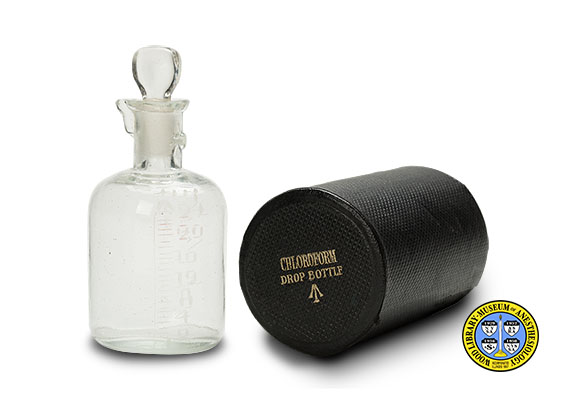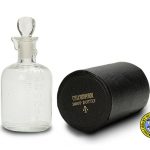British Chloroform Drop Bottle
First synthesized in 1831, chloroform was first used as an anesthetic in November, 1847 when Scottish physician James Y. Simpson introduced it into clinical practice. Not long after its introduction, some physicians began to recognize an association between chloroform anesthesia and the occurrence of sudden death during surgery. Despite this, chloroform continued to be a popular choice of anesthetic. It produced anesthesia much more quickly than ether, its scent was more pleasant, it did not cause the severe postoperative nausea and vomiting that ether did, and it was non-explosive.
In WWII, the British armed forces chose a chloroform apparatus for use by parachute troops. Despite the risk of cardiac arrest in some patients, chloroform was judged to be a safer alternative to explosive ether in this situation. Chloroform degrades when exposed to light, so it was commonly stored in amber bottles. The chloroform in this clear glass bottle was protected from light by the paperboard tube that accompanied it.
Catalog Record: British Chloroform Drop Bottle
Access Key: alml
Accession No.: 2000-10-30-3
Title: [Chloroform drop bottle.]
Publisher: [Place of manufacture not indicated] : [Name of manufacturer not incicated],
[between 1939 and 1945?].
Physical Descript: 1 bottle : glass, paperboard ; 13.5 cm in height x 6.5 cm diameter.
Subject: Chloroform.
Subject: Drug Packaging.
Note Type: General
Notes: The date range for the possible year of manufacture of this bottle is an
estimate based on information from the seller (used during World War II). The
date range could change if documentation, or expert opinion, indicates that
it should be corrected.
Note Type: Citation
Notes: Guthrie D. The first use of chloroform in surgery [abstract 833]. Br Med Bull
1946;4(2):142.
Note Type: Citation
Notes: Matsuki A, Zsigmond EK. The introduction of chloroform anesthesia in the
United States. Anesth Analg. 1974;53(1):148-151. https://journals.lww.
com/anesthesia-analgesia/pages/articleviewer.
aspx?year=1974&issue=01000&article=00037&type=abstract. Accessed March 24,
2015.
Note Type: Citation
Notes: Payne JP. Chloroform in clinical anaesthesia. Br J Anaesth. 1981;53(suppl
1):11s-15s.
Note Type: Physical Description
Notes: One clear glass chloroform botttle with glass stopper; It is accompanied by a
cylindricle paperboard tube covered in black paper; The measurement in the
physical description field (13.5 cm in height x 6.5 cm diameter) is of the
paperboard tube; The bottle measures approximately 11 cm in height and 5 cm
diameter; The neck of the drop bottle has a small spout; The bottle is marked
with a verticle scale in increments of one, which are numbered at 1, 2, 4, 8,
12, 16, 20 and 24; “DR” is marked above the scale; On the other side of the
bottle about 3 cm below the neck is an upward arrow, with the number 1, or
“I” printed below it; “CHLOROFORM [new line] DROP BOTTLE” is marked in gold
lettering on one end of the tube; Below this lettering is a symbol that looks
like an upward pointing arrow.
Note Type: Reproduction
Notes: Photographed by Mr. Steve Donisch November 12, 2014.
Note Type: Acquisition
Notes: Donated to the WLM by George S. Bause, MD, the Wood Library-Museum of
Anesthesiology Honorary Curator.
Note Type: Historical
Notes: Although chloroform was first synthesized in 1831, it was not used as an
anesthetic until November, 1847 when Scottish physician James Y. Simpson
introduced it into clinical practice. Not long after its introduction, some
physicians began to recognize an association between chloroform anesthesia
and the occurrence of sudden death during surgery. Despite this, chloroform
continued to be a popular choice of anesthetic. It produced anesthesia much
more quickly than ether, its scent was more pleasant, it did not cause as
severe postoperative nausea and vomiting as ether did, and it was
non-explosive.
The first use of chloroform in the U.S. was reported by Chapin A. Harris, a
professor of dentistry at the Baltimore College of Dental Surgery. His short
letter describing its use was published in the December 29, 1847 issue of the
Boston Medical Surgical Journal. Although chloroform was widely used for a
number of years in the U.S., including during the Civil War, it was never as
popular here as it was in Great Britain and Europe.
A wide variety of apparatus were developed for the administration of
chloroform, such as the Vernon Harcourt inhaler and the Junker inhaler.
However, the most popular method of administration involved a cloth or gauze
over the patient’s nose and mouth. The gauze would be wetted with chloroform
and then simply placed over the patient’s nose and mouth. Often, the gauze
was held away from the patient’s face by a wire mask, like the Kirchhoff or
Yankauer masks. To maintain the anesthesia, chloroform was slowly added to
the gauze from the bottle drop by drop. Chloroform degrades when exposed to
light, so it was commonly stored in amber bottles. The chloroform in this
clear glass bottle was protected by the paperboard tube that accompanied it.
Note Type: Publication
Notes: Bryn Thomas K. Chloroform: commissions and omissions. Proc R Soc Med.
1974;67(8):723-730. https://www.ncbi.nlm.nih.gov/pmc/articles/PMC1645794/.
Accessed March 24, 2015.
Note Type: Exhibition
Notes: Exhibited at the National World War II Museum in New Orleans, October, 2014;
Selected for the WLM website museum exhibit (noted January, 2015).


